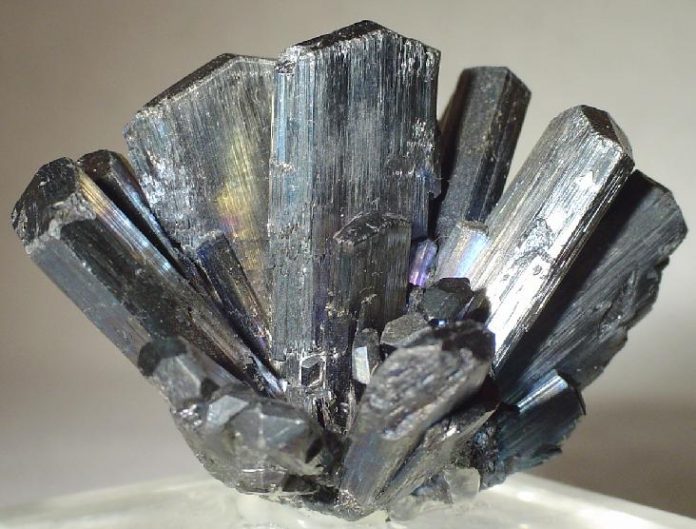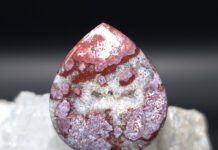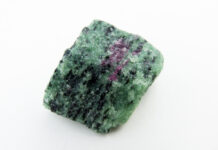
by Steve Voynick
With its intricate clusters of interlocking crystals and silvery, metallic luster, stibnite is, not surprisingly, a favorite among mineral collectors. But stibnite is also interesting for its iridescence, tarnish and flexibility, as well as its prominently striated, and sometimes slightly curved, prisms.
Stibnite, or antimony trisulfide (Sb2S3), is the most abundant of the roughly 100 antimony-bearing minerals. Antimony’s chemical symbol (Sb) stems from stibium, the Latin word for stibnite. The origin of the word “antimony”, however, is uncertain. One possibility is the 15th-century Middle English word antimonie, which literally means “monk-killer”. This may be an allusion to the metal’s toxicity and the fact that many alchemists who had the misfortune to work with it were monks. Like antimony, stibnite is also toxic and precautions like hand washing should always be exercised after handling specimens.
Elemental antimony is dull, brittle, and silvery-gray to bluish-white in color. About as common as silver, it ranks 64th among the elements in crustal abundance. As a semimetal, it exhibits characteristics of both metals and nonmetals. In stibnite and other minerals, antimony forms metallic cations and weak metallic bonds.
Stibnite’s unusual crystal lattice structure explains many of its physical properties. Stibnite molecules, which have the shape of square-based pyramids, are arranged in layers within the lattice and joined by weak metallic bonding to create planes of perfect, one-directional cleavage. Weak metallic bonding explains both stibnite’s softness (Mohs 2) and low melting point of 1015°F (546°C)—low enough to fuse in a candle flame.
During crystal growth, stibnite’s planes of perfect, one-directional cleavage functions as “gliding” planes that account for its lengthwise striations and the slight curvature of its prisms. Because of physical and thermal stresses incurred during the growth process, this plane frequently displaces, or “glides”, causing subsequent crystal growth to proceed along new axes. Repeated displacement creates new crystal-face edges that appear as stibnite’s diagnostic, pronounced longitudinal striations. Displacement also generates lattice stresses that cause stibnite prisms to curve, an effect that is most noticeable in longer prisms.
Stibnite’s metallic luster is due to the weak metallic bonding between its molecular layers and the inability of its sulfur ions to completely shield its antimony ions. Metallic bonding creates a pool of free-moving electrons. The manner in which light interacts with these free electrons produces stibnite’s metallic luster. Like all minerals with a metallic luster, stibnite is opaque, meaning that it reflects, but does not transmit, light.
As an idiochromatic, or self-colored, mineral, stibnite’s silvery-gray color is caused by its essential elemental components and the nature of its crystal structure. Incident light striking the surface electrons is absorbed more or less equally across the visible spectrum. Light energizes these surface electrons, which return to their normal levels by releasing excess energy in wavelengths that we perceive as a neutral silvery-gray, with a subtle, but attractive, hint of blue.
This basic silvery-gray color is usually modified by tarnish and iridescence. Tarnish forms when microscopic particles of elemental antimony separate from the crystal lattice to create a thin film on the stibnite surface. Because of their disassociation from the pool of free-moving electrons, the metallic-bonding strength among these particles is decreased, and they reflect less light. Subsequently, the metallic luster is replaced by a dull, dark tarnish.
This microscopically thin tarnish also produces the phenomenon of optical interference and flashes of rainbowlike iridescence. Interference occurs when two or more light waves overlap. When incident light strikes tarnished stibnite, a portion is reflected from the tarnish film, while the remaining light penetrates the film and is reflected from the lower stibnite surface. When these two reflected light waves reinforce each other in frequency, phase and amplitude, the colors we perceive exhibit the vivid, “electric” character of iridescence.
Stibnite is a fascinating mineral, and intricate clusters of interlocking, silvery-gray crystals are among its many interesting features.















